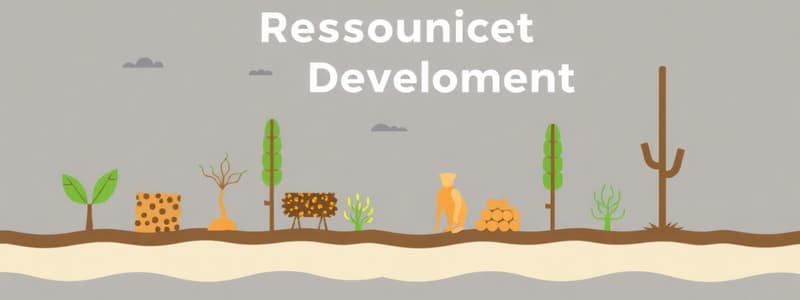Podcast
Questions and Answers
In what scenario would a yellow soil most likely be observed?
In what scenario would a yellow soil most likely be observed?
- In arid climates with high salt content.
- When iron diffuses in crystalline rocks under dry conditions.
- In areas with intense leaching due to heavy rainfall.
- When iron in the soil is in a hydrated form. (correct)
What primary climate condition contributes significantly to the formation of laterite soil?
What primary climate condition contributes significantly to the formation of laterite soil?
- Cold climate with consistent snow cover.
- Alternate wet and dry seasons in tropical and subtropical regions. (correct)
- Consistently high rainfall and low temperatures.
- Continuous dry conditions with high evaporation rates.
What is the effect of the 'Kankar' layer in arid soils?
What is the effect of the 'Kankar' layer in arid soils?
- It obstructs water infiltration due to its high calcium content. (correct)
- It enhances the soil's water retention capabilities.
- It enriches the soil with humus, promoting fertility.
- It facilitates the deep infiltration of water into the soil profile.
Which of the following characteristics is least likely to be associated with arid soils?
Which of the following characteristics is least likely to be associated with arid soils?
How can arid soils be made cultivable?
How can arid soils be made cultivable?
Which characteristic distinguishes Khadar soil from Bangar soil?
Which characteristic distinguishes Khadar soil from Bangar soil?
Black soils are well known for which of the following properties?
Black soils are well known for which of the following properties?
What is a significant factor contributing to the development of red soil?
What is a significant factor contributing to the development of red soil?
Why do black soils develop deep cracks during hot weather?
Why do black soils develop deep cracks during hot weather?
In which type of environment is laterite soil typically found, and what is a common characteristic related to humus content?
In which type of environment is laterite soil typically found, and what is a common characteristic related to humus content?
What makes alluvial soils in the upper reaches of river valleys (piedmont plains) different from those in lower reaches?
What makes alluvial soils in the upper reaches of river valleys (piedmont plains) different from those in lower reaches?
Which of the following is a significant challenge associated with laterite soils?
Which of the following is a significant challenge associated with laterite soils?
For which type of crop is red laterite soil in Tamil Nadu, Andhra Pradesh and Kerala particularly suitable?
For which type of crop is red laterite soil in Tamil Nadu, Andhra Pradesh and Kerala particularly suitable?
Which combination of characteristics primarily determines the type of soil formed in a region?
Which combination of characteristics primarily determines the type of soil formed in a region?
Alluvial soils are known for their fertility. What contributes most to this high fertility?
Alluvial soils are known for their fertility. What contributes most to this high fertility?
How does the age of alluvial soil affect its composition and fertility?
How does the age of alluvial soil affect its composition and fertility?
In which of the following geographical settings are alluvial soils predominantly found?
In which of the following geographical settings are alluvial soils predominantly found?
Why are regions with alluvial soils often densely populated?
Why are regions with alluvial soils often densely populated?
Which type of soil is most suitable for cotton cultivation and is also known as 'regur'?
Which type of soil is most suitable for cotton cultivation and is also known as 'regur'?
How can soils in drier areas be made more productive?
How can soils in drier areas be made more productive?
Which geological formation is primarily associated with the formation of black soil?
Which geological formation is primarily associated with the formation of black soil?
Flashcards
Alluvial Soil
Alluvial Soil
Soil consisting of sand, silt, and clay in varying amounts, commonly found in river valleys.
Bangar Soil
Bangar Soil
Older alluvial soil with a higher concentration of 'kanker' nodules (calcareous concretions).
Khadar Soil
Khadar Soil
Newer alluvial soil, generally more fertile than Bangar soil.
Black Soil
Black Soil
Signup and view all the flashcards
Cracking in Black Soil
Cracking in Black Soil
Signup and view all the flashcards
Red Soil
Red Soil
Signup and view all the flashcards
Humus-Poor Soil
Humus-Poor Soil
Signup and view all the flashcards
Laterite Soil Uses
Laterite Soil Uses
Signup and view all the flashcards
Industrial Effluents
Industrial Effluents
Signup and view all the flashcards
Soil Profile
Soil Profile
Signup and view all the flashcards
Parent Bedrock
Parent Bedrock
Signup and view all the flashcards
Soil Composition
Soil Composition
Signup and view all the flashcards
Black Soil (Regur)
Black Soil (Regur)
Signup and view all the flashcards
Yellow and Red Soils Location
Yellow and Red Soils Location
Signup and view all the flashcards
Reddish Color Origin
Reddish Color Origin
Signup and view all the flashcards
Yellow Soil Condition
Yellow Soil Condition
Signup and view all the flashcards
Laterite Soil Climate
Laterite Soil Climate
Signup and view all the flashcards
Laterite Soil Formation
Laterite Soil Formation
Signup and view all the flashcards
Study Notes
- Resources are essential for human survival and maintaining the quality of life
- Anything available in environment that satisfies our needs, can be technologically accessed, is economically feasible and culturally acceptable is a resource
Resource Transformation
- Interaction of nature, technology, and institutions is involved
- Human beings use technology to interact with nature and create institutions to speed up economic development
Resource Classification
- On the basis of origin: Biotic and Abiotic
- On the basis of exhaustibility: Renewable and Non-Renewable
- On the basis of ownership: Individual, Community, National and International
- On the basis of the status of development: Potential, Developed Stock and Reserves
Development Issues
- Resources were considered free gifts of nature, leading to indiscriminate use
- Problems include:
- Depletion of resources for individual greed
- Accumulation of resources in few hands, dividing society into rich and poor
- Indiscriminate exploitation leading to global ecological crises
Sustainable Development
- Aims for economic development without environmental damage
- Focuses on not compromising the needs of future generations
Rio de Janeiro Earth Summit 1992
- Convened in June 1992 with over 100 heads of state in Brazil
- Addressed pressing environmental and socio-economic development issues
- Leaders signed the Declaration on Global Climatic Change and Biological Diversity
- Adopted Agenda 21 for Sustainable Development in the 21st century
Resource Planning
- Involves judicious resource use
Agenda 21
- Declaration signed in 1992 at the UNCED in Rio de Janeiro
- Aims for global sustainable development
- Addresses environmental damage, poverty, and disease through cooperation
Resource Planning in India
- Involves:
- Identifying and inventorying resources across regions
- Creating a planning structure with appropriate technology and skills
- Matching development plans with overall national plans
- India focused on achieving resource planning goals from the First Five Year Plan after Independence
Factors Affecting Development
- Availability of resources is necessary, but not sufficient for development
- Appropriate technology and institutions are also required
- Colonization history shows that higher technological development allowed colonizers to exploit resources
Resource Conservation
- Vital for developmental activities to avoid socio-economic and environmental problems
- Irrational consumption and over-utilization of resources creates too many problems
Gandhian Philosophy
- Placed greedy individuals as cause of resource depletion
- Voiced concern about resource conservation
Land Resources
- Critical natural resource that supports various aspects of life
- Finite asset which requires careful planning
Land Features of India
- Includes mountains, plateaus, plains, and islands
- 43% is plain, suitable for agriculture and industry
- 30% are mountains, ensuring river flow and supporting tourism
- 27% is plateau, rich in minerals, fossil fuels, and forests
Land Utilization
- Forests
- Land not available for cultivation
- Other uncultivated land
- Fallow lands
- Net sown area
Land Use Pattern
- Determined by physical factors and human factors
- Physical includes topography, climate, and soil types
- Human includes population density, technological capability, and culture
Soil Composition
- Consists of both organic (humus) and inorganic materials
- Formation factors include soil formation, colour, thickness, texture, age, and chemical/physical properties
Alluvial Soils
- Widely spread and important
- Northern plains created by the Indus, Ganga, and Brahmaputra rivers
- Potash, phosphoric acid and lime rich
- Ideal for sugarcane, wheat, and paddy
- Divided into Old alluvial (Bangar) and New alluvial (Khadar)
Black Soils
- Ideal for growing cotton, retaining moisture and soil nutrients
- Typical of the Deccan trap region, made up of lava flows
Soil Erosion
- Denudation of soil cover and subsequent washing down
- Can cause an imbalance in soil levels
- Human activities: deforestation, over-grazing, mining, and construction
- Natural forces: Includes wind, glacier, and water
Soil Conservation Techniques
- Ploughing along contour lines
- Terrace cultivation
- Strip cropping
- Creating shelter belts
Studying That Suits You
Use AI to generate personalized quizzes and flashcards to suit your learning preferences.
Related Documents
Description
Understand resources, essential for human survival and quality of life. Explore resource transformation through nature, technology, and institutions. Learn about resource classification based on origin, exhaustibility, ownership and developmental status and associated developmental issues.




